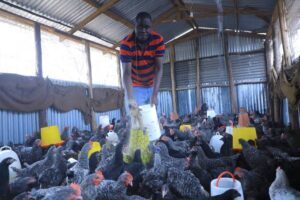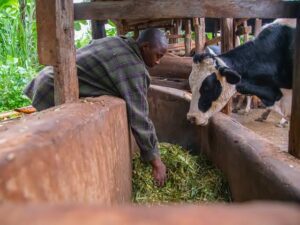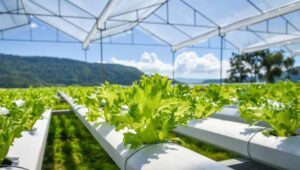Last updated on March 2nd, 2024 at 05:53 pm
Pilipili Hoho farming in Kenya or Capsicum farming
Pilipili hoho, commonly known as capsicum or bell pepper, is a popular crop grown in Kenya for its nutritional and economic benefits.
This crop is highly valued for its versatility and is used in various cuisines worldwide, from salads and stir-fries to soups and stews. Pilipili hoho is also known for its high nutritional value, being an excellent source of vitamins A and C, fiber, and antioxidants.
Pilipili hoho farming has become increasingly popular in Kenya, thanks to its high profitability and low input costs. The crop can be grown in both open fields and greenhouses, making it suitable for a wide range of farmers, regardless of their scale of operation.
The importance of pilipili hoho farming in Kenya cannot be overstated. It provides a source of income for farmers and creates employment opportunities along the value chain, from seed production and distribution to marketing and sales. The crop also contributes to food security by providing a nutritious food source for households and communities.
In this article, we will explore the essential aspects of pilipili hoho farming in Kenya, from site selection to harvesting and post-harvest handling.
We will provide practical tips and recommendations to help farmers optimize their yields and profits.
Whether you are a small-scale farmer looking to diversify your crop portfolio or a large commercial grower seeking to expand your production capacity, this article will serve as a valuable resource for your pilipili hoho farming journey.
1. Site Selection for Pilipili Hoho farming in Kenya
When choosing a site for pilipili hoho farming in Kenya, there are several factors that should be considered to ensure the success of the crop. Here are some important factors to keep in mind
a) Soil requirements and preparation
Pilipili hoho thrives in well-drained soils with a pH range of 6.0-6.8. The soil should also be rich in organic matter and nutrients, so it’s important to conduct a soil test to determine any nutrient deficiencies that need to be corrected.
To prepare the soil for planting, remove any weeds or debris and loosen the soil to a depth of 15-20 cm. Adding compost or well-rotted manure can also help to improve soil fertility.
Also Read: Beginner’s Guide to Okra Farming in Kenya
b) Necessary Climatic conditions
Pilipili hoho requires warm temperatures and plenty of sunlight to grow. The ideal temperature range for the crop is 21-27°C, and it needs at least 6 hours of sunlight per day.
The crop is sensitive to frost and should be protected from cold temperatures. In areas with high rainfall, it’s important to ensure proper drainage to prevent waterlogging.
c) Access to water
Pilipili hoho requires consistent watering, especially during the growing season. Access to a reliable source of water is therefore critical, whether through irrigation systems or natural rainfall.
d) Proximity to markets
When choosing a site for pilipili hoho farming, it’s important to consider the distance to potential markets. This will help to minimize transportation costs and ensure the freshness and quality of the harvested produce.
By taking these factors into consideration, farmers can choose a suitable site for pilipili hoho farming that will support healthy growth and high yields of this profitable crop.
Here’s a table outlining the requirements to start one acre of Capsicum farming in Kenya
| Requirements | Details |
|---|---|
| Land | One acre of land with well-draining soil, preferably sandy loam soil. |
| Seeds | High-quality Capsicum seeds that are disease-resistant and well-suited to the local growing conditions. |
| Fertilizers | Organic or inorganic fertilizers rich in nitrogen, phosphorus, and potassium. |
| Pesticides | Chemical or organic pesticides to control pests and diseases. |
| Water | Adequate water supply for irrigation, especially during the dry season. |
| Labor | Skilled and experienced labor for land preparation, planting, weeding, and harvesting. |
| Equipment | Tractor or other farm equipment for land preparation, irrigation, and harvesting. |
| Marketing | Knowledge of the market demand and the ability to access markets to sell the produce. |
Potential profits for an acre of Capsicum farming in Kenya can vary depending on several factors, such as market demand, quality of the produce, and production costs. However, here’s a rough estimate based on average prices:
| Produce | Quantity | Price (Kshs.) | Total Revenue (Kshs.) |
|---|---|---|---|
| Capsicum | 25,000 kg | 50 | 1,250,000 |
| Total Revenue | 1,250,000 | ||
| Production Costs | 600,000 | ||
| Net Profit | 650,000 |
Note: The above table is a rough estimate and actual profits may vary based on different factors such as location, production costs, and market demand.
Also Read: Mango Farming in Kenya
2. Seed selection and planting
Pilipili hoho seeds are the starting point for successful pilipili hoho farming in Kenya. Here are some important considerations for seed selection and planting:
Types of pilipili hoho seeds available in Kenya
There are two main types of pilipili hoho seeds available in Kenya: hybrid and open-pollinated seeds.
Hybrid seeds are developed through controlled pollination of two different varieties of pilipili hoho to produce plants with specific desirable traits, such as higher yield or disease resistance.
Open-pollinated seeds, on the other hand, are produced through natural pollination and are less predictable in terms of their characteristics.
Seed treatment methods
Before planting, pilipili hoho seeds should be treated to protect them from soil-borne diseases and pests.
Seed treatment methods include hot water treatment, chemical treatment, and biological treatment.
Hot water treatment involves immersing the seeds in hot water for a short period of time to kill any disease-causing organisms.
Chemical treatment involves using fungicides or insecticides to control pests and diseases. Biological treatment involves using beneficial microorganisms to protect the seeds from pathogens.
Planting techniques and spacing
Pilipili hoho can be planted directly in the field or in seedling trays for transplanting later.
If planting directly in the field, prepare the soil by tilling and adding organic matter such as compost or manure.
Plant the seeds at a depth of about 2-3 cm and cover lightly with soil. Ensure that the soil is moist but not waterlogged.
If using seedling trays, fill the trays with a well-draining seedling mix and plant one seed per cell. Keep the trays in a warm and humid environment until the seedlings emerge.
Pilipili hoho plants should be spaced at a distance of 60-90 cm between rows and 30-45 cm between plants within the row. This spacing allows for proper air circulation, reduces competition for nutrients and water, and facilitates pest and disease management.
In conclusion, selecting the right type of seed, treating the seeds appropriately, and planting them using proper techniques are critical factors for successful pilipili hoho farming in Kenya.
Read Also: Cabbage farming in Kenya
3. Crop management
Successful pilipili hoho farming in Kenya requires proper crop management practices. Here are some important aspects to consider:
Irrigation and water management
Capsicum plants require adequate water to grow well, especially during the flowering and fruiting stages.
Irrigation can be done using drip irrigation or sprinklers, depending on the availability of water and the size of the farm.
It is important to ensure that the soil is well-drained to avoid waterlogging, which can lead to root rot.
Fertilization and soil nutrition
Capsicum plants require sufficient nutrients to produce healthy and high-quality fruits.
Soil testing can help determine the type and amount of fertilizers required. Organic manure and compost can also be used to improve soil fertility.
Nutrient deficiencies can manifest as stunted growth, yellowing of leaves, and reduced fruit size.
Pest and disease management
Capsicum plants are susceptible to pests and diseases such as aphids, thrips, whiteflies, powdery mildew, and bacterial spot.
Regular scouting and monitoring can help detect and prevent the spread of pests and diseases.
Integrated pest management (IPM) practices such as cultural controls, biological controls, and chemical controls can be used to manage pests and diseases.
Cultural controls include practices such as crop rotation, use of resistant varieties, and sanitation.
Biological controls involve the use of natural enemies such as predators, parasites, and pathogens to control pests.
Chemical controls involve the use of pesticides, which should be used with caution to avoid negative effects on the environment and human health.
By implementing proper crop management practices, pilipili hoho farmers in Kenya can achieve high yields and quality produce. It is important to seek expert advice and stay updated on the latest farming techniques and technologies to improve productivity and profitability.
4. Harvesting and post-harvest handling pilipili Hoho farming in Kenya
Harvesting is a crucial stage in pilipili hoho farming as it determines the yield and quality of the produce. The following are some key considerations when harvesting and handling pilipili hoho:
Optimal timing for harvesting
Pilipili hoho can be harvested at various stages of maturity, depending on the intended use and market demand.
For instance, green or unripe pilipili hoho is commonly used in salads and stir-fries, while ripe or red pilipili hoho is preferred for roasting and stuffing. It is important to observe the recommended maturity stage and harvesting frequency to avoid over-ripening or under-ripening of the crop.
Proper handling and storage
After harvesting, pilipili hoho should be handled with care to avoid bruising or damage that can reduce its shelf life and market value.
The crop should be sorted, graded, and packed in clean and dry crates or bags. It is also advisable to store pilipili hoho at the recommended temperature and humidity levels to minimize spoilage and decay. Generally, pilipili hoho can be stored for up to two weeks under optimal conditions.
Value addition and market opportunities
Pilipili hoho has a wide range of applications in the food industry, including as a flavoring agent, food colorant, and condiment.
As such, there are various value addition opportunities for pilipili hoho farmers, such as processing into sauces, pastes, and powders.
It is also important to explore various marketing channels, such as direct sales to consumers, supply to supermarkets, and export to regional and international markets.
In conclusion, proper harvesting and post-harvest handling practices are critical in maximizing the profitability of pilipili hoho farming. By observing the recommended guidelines and exploring value addition and market opportunities, farmers can enhance the quality and value of their produce and contribute to the growth of the agricultural sector in Kenya.
Also Read: Avocado farming in kenya
Conclusion
In conclusion, pilipili hoho farming is a highly profitable venture in Kenya that has great potential for growth. With the right site selection, seed selection, and crop management techniques, farmers can achieve high yields and maximize their profits.
When it comes to harvesting and post-harvest handling, it is important to harvest pilipili hoho at the optimal time to ensure maximum quality and shelf life. Proper handling and storage of the harvested produce will also help to minimize losses and maintain the quality of the product.
In addition, farmers can explore value addition options such as processing and packaging to increase their market opportunities and profitability. Pilipili hoho is a highly sought-after product in local and international markets, making it a viable crop for export.
Overall, pilipili hoho farming presents a promising opportunity for farmers in Kenya to diversify their income streams and contribute to the growth of the agricultural sector. With the right resources, knowledge, and support, farmers can take advantage of this opportunity and reap the benefits of successful pilipili hoho farming.



